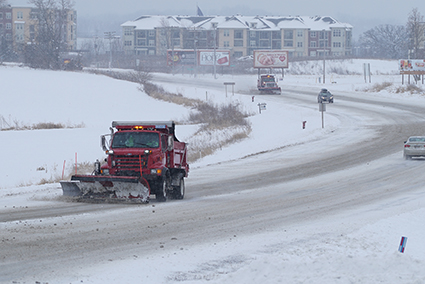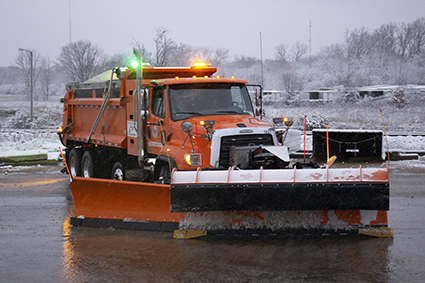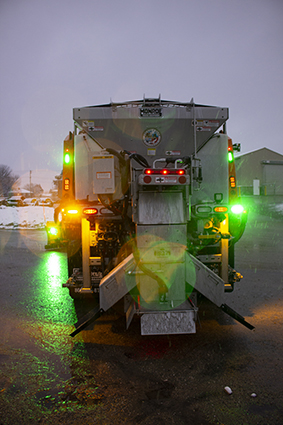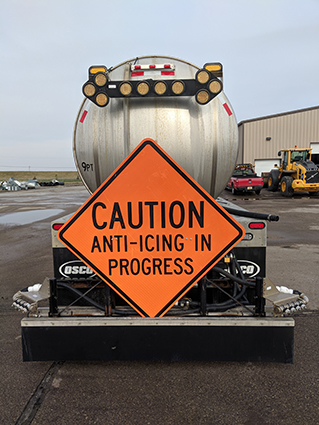 How many snowplows does the department own?
How many snowplows does the department own?
The department does not own any snowplows. Instead, the department contracts with the 72 county highway departments to plow and provide ice control on all state and US-numbered highways and the Interstate system. The county highway departments have 754 snowplow routes that cover the state highway system throughout the state.
Why does the department contract with the county highway departments for maintenance on state maintained highways?
The system was set up over 100 years ago. Legislative audits have shown that this arrangement is not only cost effective but in the best interest of the citizens of Wisconsin and the users of our state highway system.
Why do we salt the roadways in the winter?
Salt is used to make the roadways safer during the winter. It lowers the freezing point of snow and ice and keeps the snow "workable" so it is more easily removed. Salt can be used for anti-icing, de-icing, or melting. Anti-icing is a technique where a chloride is applied to the roadway prior to a storm to prevent the snow/ice from bonding to the pavement. De-icing and melting is when a chloride is applied after the storm has begun in order to break up ice and snow pack or to melt glare/black ice.
What are the limitations of road salt?
The minimum practical application range for salt is a pavement temperature of 15-20°F and above. While salt will melt snow and ice down to a pavement temperature of -6°F, it can melt over five times as much ice at 30°F as at 20°F. Thus, the effectiveness of salt is sensitive to small differences in pavement temperature. Counties will attempt to apply only the amount required for temperature, time and use. Too little and the roadway will refreeze, too much is a waste of money and resources.
When the pavement temperature drops below 15°F, the effectiveness of salt is decreased significantly. At these lower temperatures, the county highway departments will typically cease straight salt applications and begin adding other chemicals to the salt such as calcium chloride or magnesium chloride that will lower the freezing point even further.
Wind conditions must also be considered when deciding on whether to apply salt or other de-icing agents. As the temperatures drop and the snow becomes dryer, the wind can begin to blow the snow across the pavement. If there is a chemical residue left on the pavement from a previous salt application, blowing snow can be attracted to the residue and stick to the pavement creating hazardous conditions that would not have existed if no de-icing agents were previously applied. This is why counties are sometimes reluctant to apply salt or chemicals when the pavement temperatures are below 15°F. The effectiveness of salt can also be affected by the type of pavement. For example, salt works better on new asphaltic (blacktop) pavements than on tined concrete pavements.
The salt being used today typically includes other ice melting de-icing agents to increase its effectiveness at lower temperatures and to help it better adhere to the pavement. Adding other de-icing agents to the salt also reduces the number of applications needed. WisDOT is always looking for new ways to reduce the amount of chlorides used to return the roadways to safe winter driving conditions. Sometimes counties use sand and other abrasives at lower temperatures to improve friction on the roadway. Abrasives have no ice melting properties and thus their use is limited.
What role does liquid brine play in Wisconsin winter maintenance?
Liquid brine is a simple mixture of salt and water used to clear winter roads. All Wisconsin counties track some use of liquid brine, and many began to incorporate salt brine decades ago. Brine is being used in several ways throughout Wisconsin, and each helps to optimize use of salt in fighting winter storms.
- Wetting roads with liquid brine before storms helps to prevent the bond of snow and ice to a driving surface is referred to as anti-icing.
- Using brine to wet granular salt as it’s distributed is called pre-wetting. Pre-wetting both helps the salt stick to a roadway and activates the chemical reaction that melts snow and ice.
- With Direct Liquid Applications (DLA), the brine solution is sprayed directly to the roadway during winter events to break the bond between snow and the pavement.
Why doesn't the department use more sand?
Our experience, and the body of research on the use of sand, indicate the benefits of abrasives (sand) applied to roadways are very minimal. Abrasives are easily displaced from the roadway by traffic and they have no ice melting properties. There are also negative environmental consequences such as air pollution and siltation of waterways. And after you factor in the higher application rates, frequency of applications, costs of sweeping and disposal, sand costs more than salt does.
What is the importance of pavement and subsurface temperatures? Why can't you just use air temperatures?
The ability of de-icing agents to melt snow and ice depends on the temperature of the roadway and not the air temperature. During the fall the pavement is often kept warmer than the surrounding air because of the warm soil. During the spring the reverse may be true. The pavement temperatures can be colder than the air because the soil is still frozen from the low winter temperatures. The sun also has a strong influence on the pavement temperatures. It can help heat the pavement and speed the melting process. Air and pavement temperatures can often differ by as much as 20 degrees Fahrenheit. For example, on a recent bitterly cold early winter day the air temperature was below 4°F and the pavement or surface temperature was 24°F, primarily because the subsurface temperature had not yet dropped below freezing.
Am I allowed to pass a snowplow?
There are no state laws that prohibit you from passing a snowplow. However, it is illegal (State Statute 346.915) to follow a snowplow closer than 200 feet upon any highway having the posted speed limit of more than 35 mph if the snowplow is engaged in snow and ice removal. The majority of crashes involving snowplows and vehicles happen when a snowplow is rear ended or hit while being passed. Snowplows have wing plow blades that can extend anywhere between 2 and 10 feet beyond the width of the truck. This wing plow blade is often not seen because of the snow cloud being kicked up by the snowplow. These wing plows can often weigh as much as a compact car.


Why am I seeing green lights on snowplows now?
Beginning in April of 2022,
Wisconsin law allows flashing green lights on county and municipal highway maintenance vehicles, including snow plows. Green flashing lights are shown to make the snow plows more visible to drivers, especially during snowstorms. Green lights create a greater contrast than other warning lights and can reduce crashes caused by a lack of visibility.
Why are there green lights on some snowplows and not others?
Green lights are an option for county and municipal maintenance vehicles, in addition to the traditional flashing red or amber lamps. The law enables individual departments to decide how to best outfit the maintenance vehicles. At this time, green light configurations are restricted to county and municipal maintenance operations only, and not for private use.
Who determines when the snowplows are called out?
Under department policy, county highway departments determine when and how to respond to a storm. The county patrol superintendent is typically responsible for calling out the crews.
Why is it that I never seem to see a snowplow during a winter storm?
The department is responsible for snow removal on 11,916 centerline miles of roadway (or 34,723 lane miles) and 5,153 bridges. With 754 routes, the average time to complete a snow route is approximately 2½-3 hours, but some cycle times can be as long as four hours. Time is also needed to load and reload the truck with de-icing materials. The number of lane miles, if placed end to end, would circle the earth.
Why does the department have its own weather reporting stations?
WisDOT has 75 specialized weather reporting stations that collect road surface information and atmospheric information that reflect conditions on the roadway. The systems measure air and pavement temperatures, relative humidity, wind speed and direction, subsurface temperatures, depth of precipitation on the roadway, and salt concentration. This information is used by weather forecasters to develop county specific forecasts. It is also used by county patrol superintendents to help determine the appropriate response to a storm.
Why the difference in performance from storm to storm?
One of the biggest factors that determine county highway department performance is the type of storm and range of temperatures. There are reportedly more than 60,000 combinations of winter storms that can hit Wisconsin during the winter and each poses unique problems to snowplow operators. Storms with low temperatures can be difficult because de-icing agents become less effective at the lower temperatures. Storms with high winds also are a challenge because the snow quickly blows back onto the roadway after the plows pass.
 Why are you spraying water on the roadway on a perfectly clear day?
Why are you spraying water on the roadway on a perfectly clear day?
We are actually spraying a liquid salt solution on the roadway that will help keep snow and ice from bonding to the pavement. Spraying a salt solution on the roadway is similar to spraying a frying pan with oil to keep food from sticking to the bottom of the pan. The salt solution acts as a barrier so that the snow and ice won't form a strong bond to the pavement. Studies show that under extremely cold conditions ice frozen to concrete has a stronger bond than concrete alone. In many locations we also spray the salt solution on bridge decks the afternoon before a predicted frost. The early application of the salt solution helps prevent frost from forming on bridge decks throughout the night.
What hours do the plows operate during a storm?
On higher volume roadways the plows usually operate 24 hours a day when the conditions warrant. There are times, however when hours need to be reduced to give operators the opportunity to rest. On lower volume highways, roadways are usually plowed between 4 a.m. and 10 p.m., when conditions warrant. If weather conditions are so severe that we are making no progress or it is unsafe for them to operate, trucks may be pulled off the road until conditions improve.
Who is responsible for the winter road condition report that I see on the internet? Where else can I get road condition information?
The Wisconsin State Patrol and the Maintenance Decision Support System (MDSS) is responsible for providing information for the winter road condition reports.
WisDOT offers traveler information, including road conditions and weather forecasts on the Internet and by telephone. Access
Wisconsin 511 or call
511.
View winter roadway conditions in other states.
What's the typical size of trucks in the department's fleet?
The county highway departments have three basic categories of trucks used in winter operations. A typical tandem quad axle and tandem tri-axle trucks have a capacity of 15 tons and the single axle truck has a capacity of 5 tons. Trucks are usually kept for about 15-20 years and then sold at auction.
Who is responsible for plowing snow on a state highway in a city or town?
It could be WisDOT or the city. In many communities, agreements between WisDOT and the city give the city full maintenance responsibility, including the removal of snow and ice, on state highways passing through those communities. These agreements can help reduce costs to WisDOT and provide for better continuity of service.
Other winter maintenance questions:
Cody Churchill, P.E.
WisDOT Winter Maintenance Engineer
cody.churchill@dot.wi.gov
(608) 266-0464
Emil Juni
WisDOT Winter Maintenance Engineer
emil.juni@dot.wi.gov
(608) 266-3833